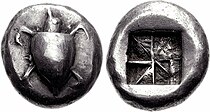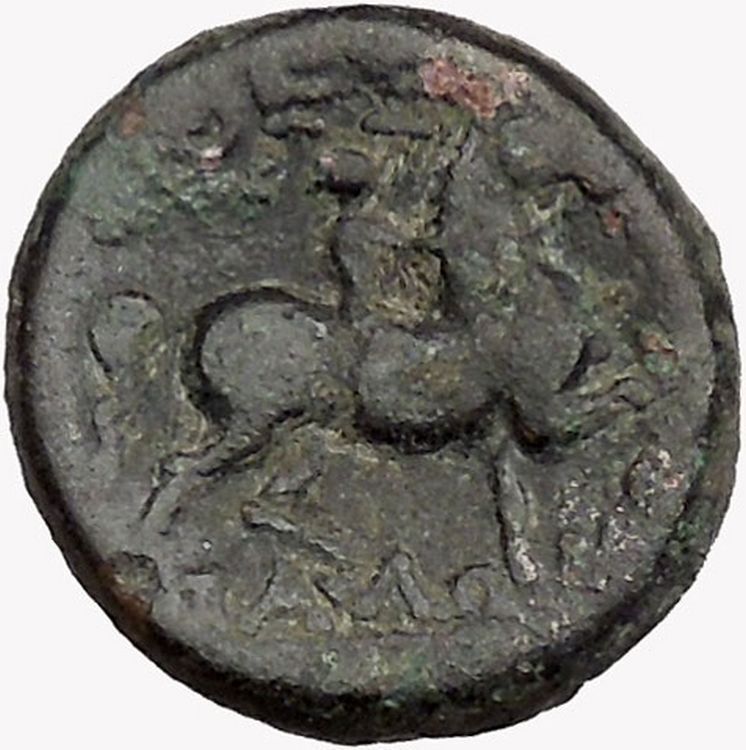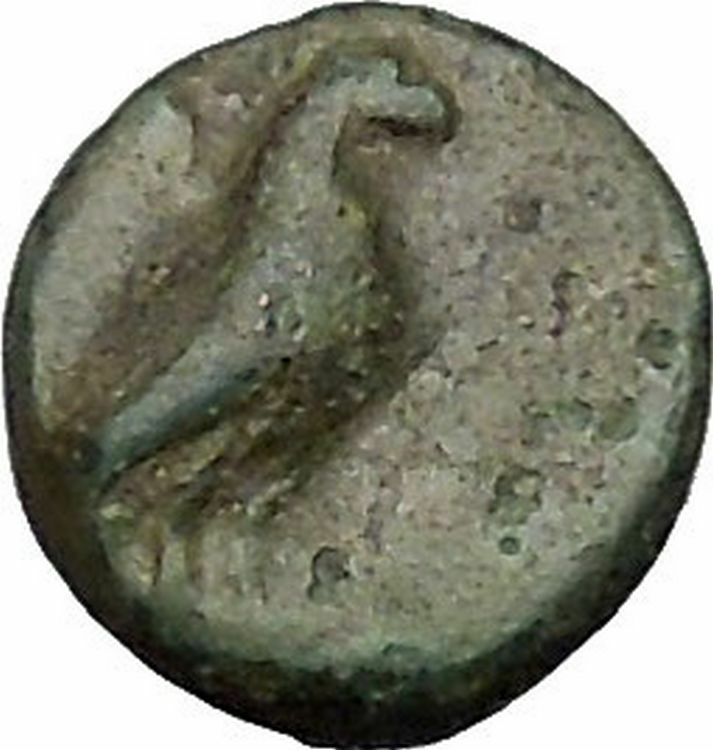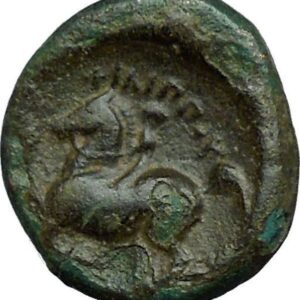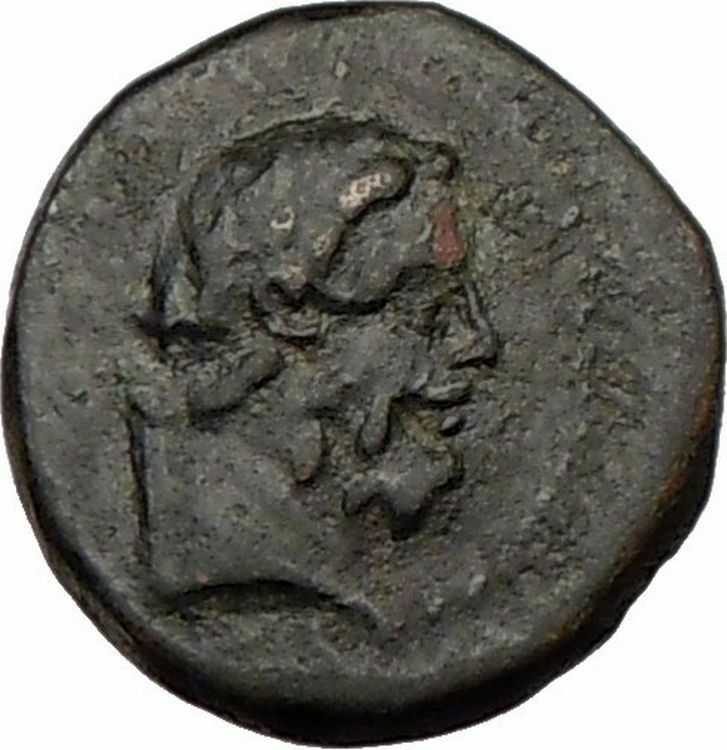|
Greek City.
Bronze 10mm (0.87 grams) Struck circa 250-100 B.C.
Head of Hercules right.
Bow in bow-case and club.
You are bidding on the exact item pictured,
provided with a Certificate of Authenticity and Lifetime Guarantee of
Authenticity.
The history of
Ancient Greek
coinage can be divided (along
with most other Greek art forms) into four periods, the
Archaic
, the
Classical
, the
Hellenistic
and the
Roman
. The Archaic period extends from the
introduction of coinage to the Greek world during the
7th century BC
until the
Persian Wars
in about 480 BC. The Classical
period then began, and lasted until the conquests of
Alexander the Great
in about 330 BC, which
began the Hellenistic period, extending until the
Roman
absorption of the Greek world in the 1st
century BC. The Greek cities continued to produce their own coins for several
more centuries under Roman rule. The coins produced during this period are
called
Roman provincial coins
or Greek Imperial Coins.
Ancient Greek coins of all four periods span over a period of more than ten
centuries.
Weight
standards and denominations

Above: Six rod-shaped obeloi (oboloi) displayed at the
Numismatic Museum of Athens
,
discovered at
Heraion of Argos
. Below: grasp[1]
of six oboloi forming one drachma

Electrum
coin from
Ephesus
, 620-600 BC, known as
Phanes’ coin
. Obverse:
Stag
grazing, ΦΑΝΕΩΣ (retrograde).
Reverse: Two incuse punches.
The basic standards of the Ancient Greek monetary system were the
Attic
standard, based on the Athenian
drachma
of 4.3 grams of silver and the
Corinthian
standard based on the
stater
of 8.6 grams of silver, that was
subdivided into three silver drachmas of 2.9 grams. The word
drachm
(a) means “a handful”, literally “a
grasp”. Drachmae were divided into six
obols
(from the Greek word for a
spit
), and six spits made a “handful”. This
suggests that before coinage came to be used in Greece, spits in
prehistoric times
were used as measures of
daily transaction. In archaic/pre-numismatic times iron was valued for making
durable tools and weapons, and its casting in spit form may have actually
represented a form of transportable
bullion
, which eventually became bulky and
inconvenient after the adoption of precious metals. Because of this very aspect,
Spartan
legislation famously forbade issuance
of Spartan coin, and enforced the continued use of iron spits so as to
discourage avarice and the hoarding of wealth. In addition to its original
meaning (which also gave the
euphemistic
diminutive
“obelisk“,
“little spit”), the word obol (ὀβολός, obolós, or ὀβελός,
obelós) was retained as a Greek word for coins of small value, still used as
such in Modern Greek
slang (όβολα, óvola,
“monies”).
The obol was further subdivided into tetartemorioi (singular
tetartemorion) which represented 1/4 of an obol, or 1/24 of a drachm. This
coin (which was known to have been struck in
Athens
,
Colophon
, and several other cities) is
mentioned by Aristotle
as the smallest silver coin.:237
Various multiples of this denomination were also struck, including the
trihemitetartemorion (literally three half-tetartemorioi) valued at 3/8 of
an obol.:
| Denominations of silver drachma |
| Image |
Denomination |
Value |
Weight |
|
|
Dekadrachm |
10 drachmas |
43 grams |
|
|
Tetradrachm |
4 drachmas |
17.2 grams |
|
|
Didrachm |
2 drachmas |
8.6 grams |
|
|
Drachma |
6 obols |
4.3 grams |
|
|
Tetrobol |
4 obols |
2.85 grams |
|
|
Triobol (hemidrachm) |
3 obols |
2.15 grams |
|
|
Diobol |
2 obols |
1.43 grams |
|
|
Obol |
4 tetartemorions |
0.72 grams |
|
|
Tritartemorion |
3 tetartemorions |
0.54 grams |
|
|
Hemiobol |
2 tetartemorions |
0.36 grams |
|
|
Trihemitartemorion |
3/2 tetartemorions |
0.27 grams |
|
|
Tetartemorion |
|
0.18 grams |
|
|
Hemitartemorion |
½ tetartemorion |
0.09 grams |
Archaic period
Archaic coinage
Uninscribed
electrum
coin from
Lydia
, 6th century BCE.
Obverse: lion head and sunburst Reverse: plain square
imprints, probably used to standardise weight
Electrum
coin from
Ephesus
, 620-600 BC. Obverse:
Forepart of stag. Reverse: Square incuse punch.
The first coins were issued in either Lydia or Ionia in Asia Minor at some
time before 600 BC, either by the non-Greek Lydians for their own use or perhaps
because Greek mercenaries wanted to be paid in precious metal at the conclusion
of their time of service, and wanted to have their payments marked in a way that
would authenticate them. These coins were made of
electrum
, an alloy of gold and silver that was
highly prized and abundant in that area. By the middle of the 6th century BC,
technology had advanced, making the production of pure gold and silver coins
simpler. Accordingly, King
Croesus
introduced a bi-metallic standard that
allowed for coins of pure gold and pure silver to be struck and traded in the
marketplace.
Coins of Aegina
Silver
stater
of Aegina, 550-530 BC.
Obv.
Sea turtle
with large pellets
down center. Rev. incuse square with eight sections. After the
end of the
Peloponnesian War
, 404 BC, Sea
turtle was replaced by the land
tortoise
.
Silver
drachma
of Aegina, 404-340 BC.
Obverse: Land
tortoise
. Reverse: inscription
AΙΓ[INAΤΟΝ] ([of the] Aeg[inetans]) “Aegina” and dolphin.
The Greek world was divided into more than two thousand self-governing
city-states (in
Greek
, poleis), and more than half of
them issued their own coins. Some coins circulated widely beyond their polis,
indicating that they were being used in inter-city trade; the first example
appears to have been the silver stater or didrachm of
Aegina
that regularly turns up in hoards in
Egypt
and the
Levant
, places which were deficient in silver
supply. As such coins circulated more widely, other cities began to mint coins
to this “Aeginetan” weight standard of (6.1 grams to the drachm), other cities
included their own symbols on the coins. This is not unlike present day
Euro coins, which are recognisably from a particular country, but
usable all over the
Euro zone
.
Athenian coins, however, were struck on the “Attic” standard, with a drachm
equaling 4.3 grams of silver. Over time, Athens’ plentiful supply of silver from
the mines at
Laurion
and its increasing dominance in trade
made this the pre-eminent standard. These coins, known as “owls” because of
their central design feature, were also minted to an extremely tight standard of
purity and weight. This contributed to their success as the premier trade coin
of their era. Tetradrachms on this weight standard continued to be a widely used
coin (often the most widely used) through the classical period. By the time of
Alexander the Great
and his
Hellenistic successors
, this large denomination
was being regularly used to make large payments, or was often saved for
hoarding.
Classical period
A
Syracusan
tetradrachm
(c. 415–405
BC)
Obverse: head of the
nymph
Arethusa
, surrounded by
four swimming
dolphins
and a
rudder
Reverse: a racing
quadriga
, its
charioteer
crowned by the
goddess
Victory
in flight.
Tetradrachm of Athens, (5th century BC)
Obverse: a portrait of
Athena
, patron goddess of
the city, in
helmet
Reverse: the owl of Athens, with an
olive
sprig and the
inscription “ΑΘΕ”, short for ΑΘΕΝΑΙΟΝ, “of the
Athenians
“
The
Classical period
saw Greek coinage reach a high
level of technical and aesthetic quality. Larger cities now produced a range of
fine silver and gold coins, most bearing a portrait of their patron god or
goddess or a legendary hero on one side, and a symbol of the city on the other.
Some coins employed a visual pun: some coins from
Rhodes
featured a
rose, since the Greek word for rose is rhodon. The use of
inscriptions on coins also began, usually the name of the issuing city.
The wealthy cities of Sicily produced some especially fine coins. The large
silver decadrachm (10-drachm) coin from
Syracuse
is regarded by many collectors as the
finest coin produced in the ancient world, perhaps ever. Syracusan issues were
rather standard in their imprints, one side bearing the head of the nymph
Arethusa
and the other usually a victorious
quadriga
. The
tyrants of Syracuse
were fabulously rich, and
part of their
public relations
policy was to fund
quadrigas
for the
Olympic chariot race
, a very expensive
undertaking. As they were often able to finance more than one quadriga at a
time, they were frequent victors in this highly prestigious event.
Syracuse was one of the epicenters of numismatic art during the classical
period. Led by the engravers Kimon and Euainetos, Syracuse produced some of the
finest coin designs of antiquity.
Hellenistic period

Gold 20-stater
of
Eucratides I
, the largest gold coin
ever minted in Antiquity.

Drachma of
Alexandria
, 222-235 AD. Obverse:
Laureate head of
Alexander Severus
, KAI(ΣΑΡ) MAP(ΚΟΣ)
AYP(ΗΛΙΟΣ) ΣЄY(ΑΣΤΟΣ) AΛЄΞANΔPOΣ ЄYΣЄ(ΒΗΣ). Reverse: Bust of
Asclepius
.
The Hellenistic period was characterized by the spread of Greek
culture across a large part of the known world. Greek-speaking kingdoms were
established in Egypt
and
Syria
, and for a time also in
Iran and as far east as what is now
Afghanistan
and northwestern
India
. Greek traders spread Greek coins across
this vast area, and the new kingdoms soon began to produce their own coins.
Because these kingdoms were much larger and wealthier than the Greek city states
of the classical period, their coins tended to be more mass-produced, as well as
larger, and more frequently in gold. They often lacked the aesthetic delicacy of
coins of the earlier period.
Still, some of the
Greco-Bactrian
coins, and those of their
successors in India, the
Indo-Greeks
, are considered the finest examples
of
Greek numismatic art
with “a nice blend of
realism and idealization”, including the largest coins to be minted in the
Hellenistic world: the largest gold coin was minted by
Eucratides
(reigned 171–145 BC), the largest
silver coin by the Indo-Greek king
Amyntas Nikator
(reigned c. 95–90 BC). The
portraits “show a degree of individuality never matched by the often bland
depictions of their royal contemporaries further West” (Roger Ling, “Greece and
the Hellenistic World”).
The most striking new feature of Hellenistic coins was the use of portraits
of living people, namely of the kings themselves. This practice had begun in
Sicily, but was disapproved of by other Greeks as showing
hubris
(arrogance). But the kings of
Ptolemaic Egypt
and
Seleucid Syria
had no such scruples: having
already awarded themselves with “divine” status, they issued magnificent gold
coins adorned with their own portraits, with the symbols of their state on the
reverse. The names of the kings were frequently inscribed on the coin as well.
This established a pattern for coins which has persisted ever since: a portrait
of the king, usually in profile and striking a heroic pose, on the obverse, with
his name beside him, and a coat of arms or other symbol of state on the reverse.
Minting
All Greek coins were
handmade
, rather than machined as modern coins
are. The design for the obverse was carved (in
incuso
) into a block of bronze or possibly
iron, called a
die
. The design of the reverse was carved into
a similar punch. A blank disk of gold, silver, or electrum was cast in a mold
and then, placed between these two and the punch struck hard with a hammer,
raising the design on both sides of the coin.
Coins as
a symbol of the city-state
Coins of Greek city-states depicted a unique
symbol
or feature, an early form of
emblem
, also known as
badge
in numismatics, that represented their
city and promoted the prestige of their state. Corinthian stater for example
depicted pegasus
the mythological winged stallion, tamed
by their hero
Bellerophon
. Coins of
Ephesus
depicted the
bee
sacred to
Artemis
. Drachmas of Athens depicted the
owl of Athena
. Drachmas of
Aegina
depicted a
chelone
. Coins of
Selinunte
depicted a “selinon” (σέλινον
– celery
). Coins of
Heraclea
depicted
Heracles
. Coins of
Gela depicted a man-headed bull, the personification of the river
Gela
. Coins of
Rhodes
depicted a “rhodon” (ῥόδον[8]
– rose
). Coins of
Knossos
depicted the
labyrinth
or the mythical creature
minotaur
, a symbol of the
Minoan Crete
. Coins of
Melos
depicted a “mēlon” (μήλον –
apple
). Coins of
Thebes
depicted a Boeotian shield.
Corinthian stater with
pegasus
Coin of
Rhodes
with a
rose
Didrachm of
Selinunte
with a
celery
Coin of
Ephesus
with a
bee
Stater of
Olympia
depicting
Nike
Coin of
Melos
with an
apple
Obolus from
Stymphalia
with a
Stymphalian bird
Coin of
Thebes
with a Boeotian shield
Coin of Gela
with a man-headed bull,
the personification of the river
Gela
Didrachm of
Knossos
depicting the
Minotaur
Commemorative coins

Dekadrachm
of
Syracuse
[disambiguation
needed]. Head of Arethusa or queen
Demarete. ΣΥΡΑΚΟΣΙΟΝ (of the Syracusians), around four dolphins
The use of
commemorative coins
to celebrate a victory or
an achievement of the state was a Greek invention. Coins are valuable, durable
and pass through many hands. In an age without newspapers or other mass media,
they were an ideal way of disseminating a political message. The first such coin
was a commemorative decadrachm issued by
Athens
following the Greek victory in the
Persian Wars
. On these coins that were struck
around 480 BC, the owl
of Athens, the goddess
Athena
‘s sacred bird, was depicted facing the
viewer with wings outstretched, holding a spray of olive leaves, the
olive tree
being Athena’s sacred plant and also
a symbol of peace and prosperity. The message was that Athens was powerful and
victorious, but also peace-loving. Another commemorative coin, a silver
dekadrachm known as ” Demareteion”, was minted at
Syracuse
at approximately the same time to
celebrate the defeat of the
Carthaginians
. On the obverse it bears a
portrait of
Arethusa
or queen Demarete.
Ancient Greek coins
today
Collections of Ancient Greek coins are held by museums around the world, of
which the collections of the
British Museum
, the
American Numismatic Society
, and the
Danish National Museum
are considered to be the
finest. The American Numismatic Society collection comprises some 100,000
ancient Greek coins from many regions and mints, from Spain and North Africa to
Afghanistan. To varying degrees, these coins are available for study by
academics and researchers.
There is also an active collector market for Greek coins. Several auction
houses in Europe and the United States specialize in ancient coins (including
Greek) and there is also a large on-line market for such coins.
Hoards of Greek coins are still being found in Europe, Middle East, and North
Africa, and some of the coins in these hoards find their way onto the market.
Coins are the only art form from the Ancient world which is common enough and
durable enough to be within the reach of ordinary collectors.
HERCULES – This celebrated
of mythological romance was at first called Alcides, but received the name of
Hercules, or Heracles, from the Pythia of Delphos. Feigned by the poets of
antiquity to have been a son of “the Thunderer,” but born of an earthly mother,
he was exposed, through Juno’s implacable hatred to him as the offspring of
Alemena, to a course of perils, which commenced whilst he was yet in his cradle,
and under each of which he seemed to perish, but as constantly proved
victorious.
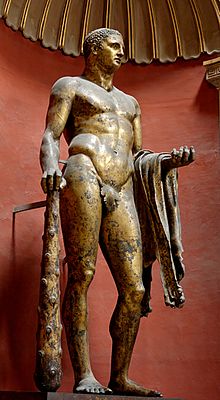
At
length finishing his allotted career with native valor and generosity, though
too frequently the submissive agent of the meanness and injustice of others, he
perished self-devotedly on the funeral pile, which was lighted on Mount Oeta.
Jupiter raised his heroic progeny to the skies; and Hercules was honored by the
pagan world, as the most illustrious of deified mortals. The extraordinary
enterprises cruelly imposed upon, but gloriously achieved, by this famous
demigod, are to be found depicted, not only on Greek coins, but also on the
Roman series both consular and imperial. The first, and one of the most
dangerous, of undertakings, well-known under the name of the twelve labors of
Hercules, was that of killing the huge lion of Nemea; on which account the
intrepid warrior is represented, clothes in the skin of that forest monarch; he
also bears uniformly a massive club, sometimes without any other arms, but at
others with a bow and quiver of arrows. On a denarius of the Antia gens he is
represented walking with trophy and club.
When his head alone is typified, as in Mucia gens, it is covered with the lion’s
spoils, in which distinctive decoration he was imitated by many princes, and
especially by those who claimed descent from him – as for example, the kings of
Macedonia, and the successors of Alexander the Great. Among the Roman emperors
Trajan is the first whose coins exhibit the figure and attributes of Hercules.
Ancient Greece is the civilization belonging to the period of
Greek history
lasting from the
Archaic period
of the 8th to 6th centuries BC
to 146 BC and the
Roman
conquest of
Greece
after the
Battle of Corinth
. At the center of this time
period is Classical Greece
, which flourished during the
5th to 4th centuries BC, at first under
Athenian
leadership successfully repelling the
military threat of
Persian invasion
. The
Athenian Golden Age
ends with the defeat of
Athens at the hands of Sparta
in the
Peloponnesian War in 404 BC. Following the conquests of
Alexander the Great
,
Hellenistic civilization
flourished from
Central Asia to the western end of the
Mediterranean Sea.
Classical
Greek culture
had a powerful influence on the
Roman
Empire, which carried a version of it to many parts of the
Mediterranean region
and
Europe,
for which reason Classical Greece is generally considered to be the seminal
culture which provided the foundation of
Western civilization
.
Chronology
There are no fixed or universally agreed upon dates for the beginning or the
end of
Classical Antiquity
. It is typically taken to
last from the 8th century BC until the 6th century AD, or for about 1,300 years.
Classical Antiquity in Greece is preceded by the
Greek Dark Ages (c.1100-c.750 BC), archaeologically characterised by
the
protogeometric
and
geometric style
of designs on pottery,
succeeded by the
Orientalizing Period
, a strong influence of
Syro-Hittite
,
Assyrian
,
Phoenician
and
Egyptian
cultures.
Traditionally, the
Archaic period
of ancient Greece is taken in
the wake of this strong Orientalizing influence during the 8th century BC, which
among other things brought the
alphabetic script
to Greece, marking the
beginning of Greek literature (Homer,
Hesiod).
The Archaic period gives way to the
Classical period
around 500 BC, in turn
succeeded by the Hellenistic period
at the death of
Alexander the Great
in 323 BC.
The history of Greece
during Classical Antiquity
may thus be subdivided into the following periods
- The
Archaic period
(c.750-c.500 BC) follows, in
which artists made larger free-standing
sculptures
in stiff, hieratic poses with
the dreamlike ‘archaic
smile‘. The Archaic period is often taken to end with the
overthrow of the last tyrant of
Athens
in 510 BC.
- The Classical period (c.500-323 BC) is characterised by a style which
was considered by later observers to be exemplary (i.e. ‘classical’)—for
instance the Parthenon
. Politically, the Classical
Period was dominated by
Athens
and the
Delian League during the 5th century, displaced by
Spartan hegemony
during the early 4th
century BC, before power shifted to
Thebes
and the
Boeotian League
and finally to the
League of Corinth
led by
Macedon
.
- The Hellenistic period (323-146 BC) is when Greek culture and power
expanded into the near and
middle east
. This period begins with the
death of Alexander and ends with the Roman conquest.
- Roman Greece
, the period between Roman
victory over the
Corinthians
at the
Battle of Corinth in
146 BC and the
establishment of Byzantium
by
Constantine
as the capital of the
Roman Empire in 330 AD.
- the
final phase of Antiquity
is the period of
Christianization
during the later 4th to
early 6th centuries, taken to be complete with the closure of the
Neoplatonic
Academy
by
Justinian I in 529 AD.
Historiography
The historical period of ancient Greece is unique in world history as the
first period attested directly in proper
historiography, while earlier ancient history or
proto-history
is known by much more
circumstantial evidence, such as annals or king lists, and pragmatic epigraphy.
Herodotus is widely known as the “father of history”, his
Histories
being eponymous of the entire
field
. Written between the 450s and 420s BC,
the scope of Herodotus’ work reaches about a century into the past, discussing
6th-century historical figures such as
Darius I of Persia,
Cambyses II and Psamtik III
, and alludes to some 8th-century
ones such as Candaules
.
Herodotus was succeeded by authors such as
Thucydides, Xenophon
,
Demosthenes, Plato
and
Aristotle.
Most of these authors were either
Athenians
or pro-Athenians, which is why far
more is known about the history and politics of Athens than of many other
cities. Their scope is further limited by a focus on political, military and
diplomatic history, ignoring economic and social history.
History
Archaic period
In the 8th century BC, Greece began to emerge from the Dark Ages which
followed the fall of the Mycenaean civilization. Literacy had been lost and
Mycenaean script
forgotten, but the Greeks
adopted the Phoenician alphabet
, modifying it to create the
Greek alphabet. From about the 9th century BC written records begin
to appear.[6]
Greece was divided into many small self-governing communities, a pattern largely
dictated by Greek geography, where every island, valley and plain is cut off
from its neighbours by the sea or mountain ranges.[7]
The Lelantine War
(c.710-c.650 BC) was an ongoing
conflict with the distinction of being the earliest documented war of the
ancient Greek period. It was fought between the important
poleis
(city-states)
of Chalcis
and Eretria
over the fertile Lelantine plain of
Euboea.
Both cities seem to have suffered a decline as result of the long war, though
Chalcis was the nominal victor.
A mercantile class
rose in the first half of the
7th century, shown by the introduction of
coinage
in about 680 BC.[citation
needed] This seems to have introduced tension to many
city-states. The
aristocratic
regimes which generally governed
the poleis were threatened by the new-found wealth of merchants, who in turn
desired political power. From 650 BC onwards, the aristocracies had to fight not
to be overthrown and replaced by
populist
tyrants
. The word derives from the
non-pejorative
Greek τύραννος tyrannos,
meaning ‘illegitimate ruler’, although this was applicable to both good and bad
leaders alike.
A growing population and shortage of land also seems to have created internal
strife between the poor and the rich in many city-states. In
Sparta,
the
Messenian Wars resulted in the conquest of
Messenia
and enserfment of the Messenians, beginning in the latter half of the 8th
century BC, an act without precedent or antecedent in ancient Greece. This
practice allowed a social revolution to occur.
The subjugated population, thenceforth known as
helots,
farmed and laboured for Sparta, whilst every Spartan male citizen became a
soldier of the
Spartan Army
in a permanently militarized
state. Even the elite were obliged to live and train as soldiers; this equality
between rich and poor served to defuse the social conflict. These reforms,
attributed to the shadowy
Lycurgus of Sparta, were probably complete by 650 BC.
Athens suffered a land and agrarian crisis in the late 7th century, again
resulting in civil strife. The
Archon
(chief magistrate)
Draco
made severe reforms to the law code in
621 BC (hence “draconian“),
but these failed to quell the conflict. Eventually the moderate reforms of
Solon
(594 BC), improving the lot of the poor but firmly entrenching the aristocracy
in power, gave Athens some stability.
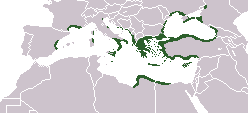
The Greek world in the mid 6th century BC.
By the 6th century BC several cities had emerged as dominant in Greek
affairs: Athens, Sparta,
Corinth
, and
Thebes
. Each of them had brought the
surrounding rural areas and smaller towns under their control, and Athens and
Corinth had become major maritime and mercantile powers as well.
Rapidly increasing population in the 8th and 7th centuries had resulted in
emigration of many Greeks to form
colonies
in
Magna
Graecia (Southern
Italy and Sicily
),
Asia Minor
and further afield. The emigration
effectively ceased in the 6th century by which time the Greek world had,
culturally and linguistically, become much larger than the area of present-day
Greece. Greek colonies were not politically controlled by their founding cities,
although they often retained religious and commercial links with them.
In this period, huge economic development occurred in Greece and also her
overseas colonies which experienced a growth in commerce and manufacturing.
There was a large improvement in the living standards of the population. Some
studies estimate that the average size of the Greek household, in the period
from 800 BC to 300 BC, increased five times, which indicates a large increase in
the average income of the population.
In the second half of the 6th century, Athens fell under the tyranny of
Peisistratos
and then his sons
Hippias
and
Hipparchos
. However, in 510 BC, at the
instigation of the Athenian aristocrat
Cleisthenes, the Spartan king
Cleomenes I helped the Athenians overthrow the tyranny. Afterwards,
Sparta and Athens promptly turned on each other, at which point Cleomenes I
installed
Isagoras as a pro-Spartan archon. Eager to prevent Athens from
becoming a Spartan puppet, Cleisthenes responded by proposing to his fellow
citizens that Athens undergo a revolution: that all citizens share in political
power, regardless of status: that Athens become a “democracy“.
So enthusiastically did the Athenians take to this idea that, having
overthrown
Isagoras and implemented Cleisthenes’s reforms, they were easily able to
repel a
Spartan-led three-pronged invasion aimed at restoring Isagoras.The
advent of the democracy cured many of the ills of Athens and led to a
‘golden age’ for the Athenians.
Classical Greece

Early Athenian
coin, depicting the head
of Athena
on the obverse and her owl
on the reverse – 5th century BC

Attic Red-figure pottery
,
kylix
by the
Triptolemos Painter
, ca. 480 BC (Paris,
Louvre
)

Delian League (“Athenian Empire”), immediately before the
Peloponnesian War
in 431 BC.
5th century
Athens and Sparta would soon have to become allies in the face of the largest
external threat ancient Greece would see until the Roman conquest. After
suppressing the Ionian Revolt
, a rebellion of the Greek cities
of Ionia,
Darius I of Persia,
King
of Kings of the
Achaemenid Empire, decided to subjugate Greece. His invasion in 490
BC was ended by the Athenian victory at the
Battle of Marathon under
Miltiades the Younger
.
Xerxes I of Persia
, son and successor of Darius
I, attempted his own invasion 10 years later, but despite his larger army he
suffered heavy casualties after the famous rearguard action at
Thermopylae
and victories for the allied Greeks
at the Battles of
Salamis
and
Plataea
. The
Greco-Persian Wars continued until 449 BC, led by the Athenians and
their Delian League
, during which time the
Macedon
,
Thrace,
the
Aegean Islands and Ionia were all liberated from Persian influence.
The dominant position of the maritime Athenian ‘Empire’ threatened Sparta and
the Peloponnesian League
of mainland Greek cities.
Inevitably, this led to conflict, resulting in the
Peloponnesian War (431-404 BC). Though effectively a stalemate for
much of the war, Athens suffered a number of setbacks. The
Plague of Athens in 430 BC followed by a disastrous military campaign
known as the Sicilian Expedition
severely weakened Athens.
An estimated one-third of Athenians died, including
Pericles,
their leader.
Sparta was able to foment rebellion amongst Athens’s allies, further reducing
the Athenian ability to wage war. The decisive moment came in 405 BC when Sparta
cut off the grain supply to Athens from the
Hellespont
. Forced to attack, the crippled
Athenian fleet was decisively defeated by the Spartans under the command of
Lysander
at
Aegospotami
. In 404 BC Athens sued for peace,
and Sparta dictated a predictably stern settlement: Athens lost her city walls
(including the Long Walls
), her fleet, and all of her overseas
possessions.
4th century
Greece thus entered the 4th century under a
Spartan hegemony, but it was clear from the start that this was weak.
A demographic crisis meant Sparta was overstretched, and by 395 BC Athens,
Argos, Thebes, and Corinth felt able to challenge Spartan dominance, resulting
in the Corinthian War
(395-387 BC). Another war of
stalemates, it ended with the status quo restored, after the threat of Persian
intervention on behalf of the Spartans.
The Spartan hegemony lasted another 16 years, until, when attempting to
impose their will on the Thebans, the Spartans suffered a decisive defeat at
Leuctra
in 371 BC. The Theban general
Epaminondas then led Theban troops into the Peloponnese, whereupon
other city-states defected from the Spartan cause. The Thebans were thus able to
march into Messenia and free the population.
Deprived of land and its serfs, Sparta declined to a second-rank power. The
Theban hegemony thus established was short-lived; at the
battle of Mantinea
in 362 BC, Thebes lost her
key leader, Epaminondas, and much of her manpower, even though they were
victorious in battle. In fact such were the losses to all the great city-states
at Mantinea that none could establish dominance in the aftermath.
The weakened state of the heartland of Greece coincided with the
Rise of Macedon, led by
Philip II
. In twenty years, Philip had unified
his kingdom, expanded it north and west at the expense of
Illyrian tribes
, and then conquered
Thessaly
and Thrace.
His success stemmed from his innovative reforms to the
Macedon army
. Phillip intervened repeatedly in
the affairs of the southern city-states, culminating in his invasion of 338 BC.
Decisively defeating an allied army of Thebes and Athens at the
Battle of Chaeronea (338 BC)
, he became de
facto hegemon of all of Greece, except Sparta. He compelled the majority of
the city-states to join the
League of Corinth, allying them to him, and preventing them from
warring with each other. Philip then entered into war against the Achemaenid
Empire but was assassinated by
Pausanias of Orestis
early on in the conflict.
Alexander
, son and successor of Philip,
continued the war. Alexander defeated
Darius III of Persia
and completely destroyed
the Achaemenid Empire, annexing it to Macedon and earning himself the epithet
‘the Great’. When Alexander died in 323 BC, Greek power and influence was at its
zenith. However, there had been a fundamental shift away from the fierce
independence and classical culture of the poleis—and instead towards the
developing
Hellenistic culture
.
Hellenistic Greece
The Hellenistic period
lasted from 323 BC, which
marked the end of the
Wars of Alexander the Great
, to the annexation
of Greece by the Roman Republic
in 146 BC. Although the
establishment of Roman rule did not break the continuity of Hellenistic society
and culture, which remained essentially unchanged until the advent of
Christianity, it did mark the end of Greek political independence.
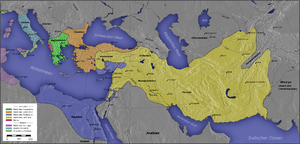
The major
Hellenistic
realms included the
Diadochi kingdoms
:
Kingdom of
Ptolemy I Soter
Kingdom of
Cassander
Kingdom of
Lysimachus
Kingdom of
Seleucus I Nicator
Epirus
Also shown on the map:
Greek
colonies
Carthage
(non-Greek)
Rome
(non-Greek)
The orange areas were often in dispute after 281 BC. The
kingdom of Pergamon
occupied some
of this area. Not shown:
Indo-Greeks
.
During the Hellenistic period, the importance of “Greece proper” (that is,
the territory of modern Greece) within the Greek-speaking world declined
sharply. The great centers of Hellenistic culture were
Alexandria and Antioch
, capitals of
Ptolemaic Egypt
and
Seleucid Syria
respectively.
The conquests of Alexander had numerous consequences for the Greek
city-states. It greatly widened the horizons of the Greeks and led to a steady
emigration, particularly of the young and ambitious, to the new Greek empires in
the east.[13]
Many Greeks migrated to Alexandria, Antioch and the many other new Hellenistic
cities founded in Alexander’s wake, as far away as what are now
Afghanistan and Pakistan
, where the
Greco-Bactrian Kingdom
and the
Indo-Greek Kingdom
survived until the end of
the 1st century BC.
After the death of Alexander his empire was, after quite some conflict,
divided amongst his generals, resulting in the
Ptolemaic Kingdom (based upon
Egypt),
the Seleucid Empire
(based on the
Levant,
Mesopotamia and
Persia
) and the
Antigonid dynasty based in Macedon. In the intervening period, the
poleis of Greece were able to wrest back some of their freedom, although still
nominally subject to the Macedonian Kingdom.
The city-states formed themselves into two leagues; the
Achaean League (including Thebes, Corinth and Argos) and the
Aetolian League (including Sparta and Athens). For much of the period
until the Roman conquest, these leagues were usually at war with each other,
and/or allied to different sides in the conflicts between the Diadochi (the
successor states to Alexander’s empire).

Territories and expansion of the Indo-Greeks.
The Antigonid Kingdom became involved in a war with the Roman Republic in the
late 3rd century. Although the
First Macedonian War
was inconclusive, the
Romans, in typical fashion, continued to make war on Macedon until it was
completely absorbed into the Roman Republic (by 149 BC). In the east the
unwieldy Seleucid Empire gradually disintegrated, although a rump survived until
64 BC, whilst the Ptolemaic Kingdom continued in Egypt until 30 BC, when it too
was conquered by the Romans. The Aetolian league grew wary of Roman involvement
in Greece, and sided with the Seleucids in the
Roman-Syrian War
; when the Romans were
victorious, the league was effectively absorbed into the Republic. Although the
Achaean league outlasted both the Aetolian league and Macedon, it was also soon
defeated and absorbed by the Romans in 146 BC, bringing an end to the
independence of all of Greece.
Roman Greece
The Greek peninsula came under
Roman
rule in 146 BC,
Macedonia
becoming a
Roman province, while southern Greece came under the surveillance of
Macedonia’s praefect. However, some Greek
poleis
managed to maintain a partial
independence and avoid taxation. The
Aegean islands
were added to this territory in
133 BC.
Athens and other Greek cities revolted in 88 BC, and the peninsula
was crushed by the Roman general
Sulla
. The Roman civil wars devastated the land
even further, until
Augustus
organized the peninsula as the
province of
Achaea
in 27 BC.
Greece was a key eastern province of the
Roman
Empire, as the
Roman
culture
had long been in fact
Greco-Roman
. The
Greek language
served as a
lingua franca in the East
and in
Italy,
and many Greek intellectuals such as
Galen
would perform most of their work in Rome
.
|


